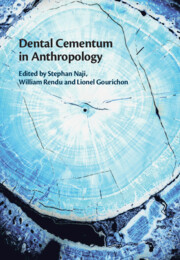Book contents
- Dental Cementum in Anthropology
- Dental Cementum in Anthropology
- Copyright page
- Dedication
- Contents
- Contributors
- Foreword
- Introduction: Cementochronology in Chronobiology
- Part I The Biology of Cementum
- Part II Protocols
- 9 Cementochronology for Archaeologists: Experiments and Testing for an Optimized Thin-Section Preparation Protocol
- 10 Optimizing Preparation Protocols and Microscopy for Cementochronology
- 11 Cementochronology Protocol for Selecting a Region of Interest in Zooarchaeology
- 12 Tooth Cementum Annulations Method for Determining Age at Death Using Modern Deciduous Human Teeth: Challenges and Lessons Learned
- 13 The Analysis of Tooth Cementum for the Histological Determination of Age and Season at Death on Teeth of US Active Duty Military Members
- 14 Preliminary Protocol to Identify Parturitions Lines in Acellular Cementum
- 15 Toward the Nondestructive Imaging of Cementum Annulations Using Synchrotron X-Ray Microtomography
- 16 Noninvasive 3D Methods for the Study of Dental Cementum
- Part III Applications
- Index
- Plate Section (PDF Only)
- References
11 - Cementochronology Protocol for Selecting a Region of Interest in Zooarchaeology
from Part II - Protocols
Published online by Cambridge University Press: 20 January 2022
- Dental Cementum in Anthropology
- Dental Cementum in Anthropology
- Copyright page
- Dedication
- Contents
- Contributors
- Foreword
- Introduction: Cementochronology in Chronobiology
- Part I The Biology of Cementum
- Part II Protocols
- 9 Cementochronology for Archaeologists: Experiments and Testing for an Optimized Thin-Section Preparation Protocol
- 10 Optimizing Preparation Protocols and Microscopy for Cementochronology
- 11 Cementochronology Protocol for Selecting a Region of Interest in Zooarchaeology
- 12 Tooth Cementum Annulations Method for Determining Age at Death Using Modern Deciduous Human Teeth: Challenges and Lessons Learned
- 13 The Analysis of Tooth Cementum for the Histological Determination of Age and Season at Death on Teeth of US Active Duty Military Members
- 14 Preliminary Protocol to Identify Parturitions Lines in Acellular Cementum
- 15 Toward the Nondestructive Imaging of Cementum Annulations Using Synchrotron X-Ray Microtomography
- 16 Noninvasive 3D Methods for the Study of Dental Cementum
- Part III Applications
- Index
- Plate Section (PDF Only)
- References
Summary
Seasonal variations directly impacted the social and economic activities of past human populations. Cementochronology is one of the methods available to address seasonality questions. It relies on the cyclic deposition rate of dental cementum observed microscopically on petrographic thin‐sections of animal teeth from archaeological contexts. However, no protocol exists to select a Region of Interest (ROI) or to identify the last cementum increment. This chapter proposes consensual biological and optical criteria for the selection of optimal ROIs and their analysis. Interobserver tests were performed to assess the criteria, as well as age and season of death, on thirty thin‐sections of modern documented reindeer teeth. Results demonstrate the accuracy, and replicability of this protocol, and emphasize the influence of training and experience for the proper implementation of cementochronology.
- Type
- Chapter
- Information
- Dental Cementum in Anthropology , pp. 201 - 214Publisher: Cambridge University PressPrint publication year: 2022
References
- 1
- Cited by



